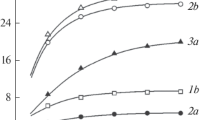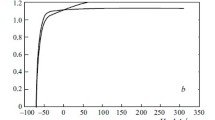Abstract
(Sm,Zr)(Co,Cu,Fe)6.0–6.8 alloys are prepared by vacuum induction melting and subsequently subjected to heat treatment in order to form a high-coercivity state, which includes annealing at 1160–1180°C for 5 h, quenching to room temperature, isothermal aging at 800°C for 20 h, and subsequent stepped tempering from 800 to 400°C at an average cooling rate of 100°C/h. The morphology and composition of main structural constituents of the alloys are studied by electron microscopy using samples in the form of individual grains separated from ingots. The hysteretic properties of the (Sm,Zr)(Co,Cu,Fe)z samples in the high-coercivity state are shown to correlate with the volume fractions of their main structural constituents, which, in turn, are controlled by the ratio of the 4f-/4d-/3d-element contents in the chemical composition of the alloy.





Similar content being viewed by others
REFERENCES
J. Fidler, T. Schrefl, S. Hoefinger, and M. Hajduga, “Recent developments in hard magnetic bulk materials,” J. Phys.: Condens. Matter 16, 455–470 (2004).
C. H. Chen, M. S. Walmer, M. H. Walmer, S. Liu, G. E. Kuhl, and G. K. Simon, “New series of Sm2TM17 magnet materials for applications at temperatures up to 550°C,” Mater. Res. Soc. Symp. Proc. 577, 277–287 (1999).
Y. Horiuchi, M. Hagiwara, K. Okamoto, T. Kobayashi, M. Endo, T. Kobayashi, T. Nakamura, and S. Sakurada, “Effects of solution treated temperature on the structural and magnetic properties of iron-rich Sm(CoFeCuZr)z sintered magnet,” IEEE Trans. Magn. 49, 3221–3224 (2013).
Y. Horiuchi, M. Hagiwara, K. Okamoto, T. Kobayashi, M. Endo, N. Sanada, and S. Sakurada, “Effect of pre-aging treatment on the microstructure and magnetic properties of Sm(Co,Fe,Cu,Zr)7.8 sintered magnets,” Mater. Trans. 55, 482–488 (2014).
Y. Horiuchi, M. Hagiwara, M. Endo, N. Sanada, and S. Sakurada, “Influence of intermediate-heat treatment on the structure and magnetic properties of iron-rich Sm(CoFeCuZr)z sintered magnets,” J. Appl. Phys. 117, 17C704 (2015).
H. Chen, Y. Wang, Y. Yao, Q. Ju, F. Yun, Y. Li, S. P. Ringer, M. Yue, and R. Zheng, “Attractive-domain-wall-pinning controlled Sm–Co magnets overcome the coercivity—remanence trade-off,” Acta Mater. 164, 196–206 (2019).
R. Gopalan, T. Ohkubo, and K. Hono, “Identification of the cell boundary phase in the isothermally aged commercial Sm(Co0.725Fe0.1Cu0.12Zr0.04)7.4 sintered magnet,” Scripta Mater. 54, 1345–1349 (2006).
D. Goll, H. H. Stadelmaier, and H. Kronmüller, “Samarium–cobalt 2:17 magnets. Analysis of the coercive field of Sm2(CoFeCuZr)17 high-temperature permanent magnets,” Scripta Mater. 63, 243–245 (2010).
H. Sepehri-Amin, J. Thielsch, J. Fischbacher, T. Ohkubo, T. Schrefl, O. Gutfleisch, and K. Hono, “Correlation of microchemistry of cell boundary phase and interface structure to the coercivity of Sm(Co0.784Fe0.100Cu0.088Zr0.028)7.19 sintered magnets,” Acta Mater. 126, 1–10 (2017).
K. Song, W. Sun, H. Chen, N. Yu, Y. Fang, M. Zhu, and W. Li, “Revealing on metallurgical behavior of iron-rich Sm(Co0.65Fe0.26Cu0.07Zr0.02)7.8 sintered magnets,” AIP Advanc. 7, 056238 (2017).
A. G. Popov, O. A. Golovnia, V. S. Gaviko, D. Yu. Vasilenko, D. Yu. Bratushev, V. I. Nithin Balaji, A. Kovács, K. G. Pradeep, and R. Gopalan, “Development of high-coercivity state in high-energy and high-temperature Sm–Co–Fe–Cu–Zr magnets upon step cooling,” J. Alloys Compd. 820, 153103 (2020).
A. Lefevre, L. Cataldo, M. Th. Cohen-Adad, and B. F. Mentzen, “Optimization of 2/17 permanent magnets using the quinary Sm–Co–Cu–Fe–Zr phase diagram,” J. Alloys Compd. 275–277, 556–559 (1998).
Y. Q. Wang, Z. F. Shang, M. Yue, D. Wu, D. T. Zhang, H. G. Zhang, and W. Q. Liu, “Correlation between Fe content and z value in Sm(CobalFexCu0.06Zr0.025)z permanent magnets,” J. Magn. Magn. Mater. 474, 417–423 (2019).
S. Wang, H. Chen, Y. Fang, C. Wang, L. Wang, M. Zhu, W. Lia, and G. C. Hadjipanayis, “Microstructure characteristics and optimization of Sm2Co17-type sintered magnets with different iron content,” J. Magn. Magn. Mater. 514, 167288 (2020).
A. G. Dormidontov, N. B. Kolchugina, N. A. Dormidontov, Y. V. Milov, and A. S. Andreenko, “Structure of alloys for (Sm,Zr)(Co,Cu,Fe)z permanent magnets : II. Composition, magnetization reversal, and magnetic hardening of main structural constituents,” Materials 13, 5426 (2020).
A. G. Dormidontov, N. B. Kolchugina, N. A. Dormidontov, and Y. V. Milov, “Structure of alloys (Sm,Zr)(Co,Cu,Fe)z permanent magnets : First level of heterogeneity,” Materials. 2020. 13 (17), 3893 (2020).
Funding
This study was supported by the Russian Science Foundation, project no. 20-19-00689.
Author information
Authors and Affiliations
Corresponding author
Ethics declarations
The authors declare that they have no conflicts of interest.
Additional information
Translated by N. Kolchugina
Rights and permissions
About this article
Cite this article
Dormidontov, N.A., Kolchugina, N.B., Prokof’ev, P.A. et al. Structural Constituents and Phases in High-Coercivity (Sm,Zr)(Co,Cu,Fe)z Alloys for Permanent Magnets. Russ. Metall. 2022, 505–511 (2022). https://doi.org/10.1134/S0036029522050032
Received:
Revised:
Accepted:
Published:
Issue Date:
DOI: https://doi.org/10.1134/S0036029522050032




